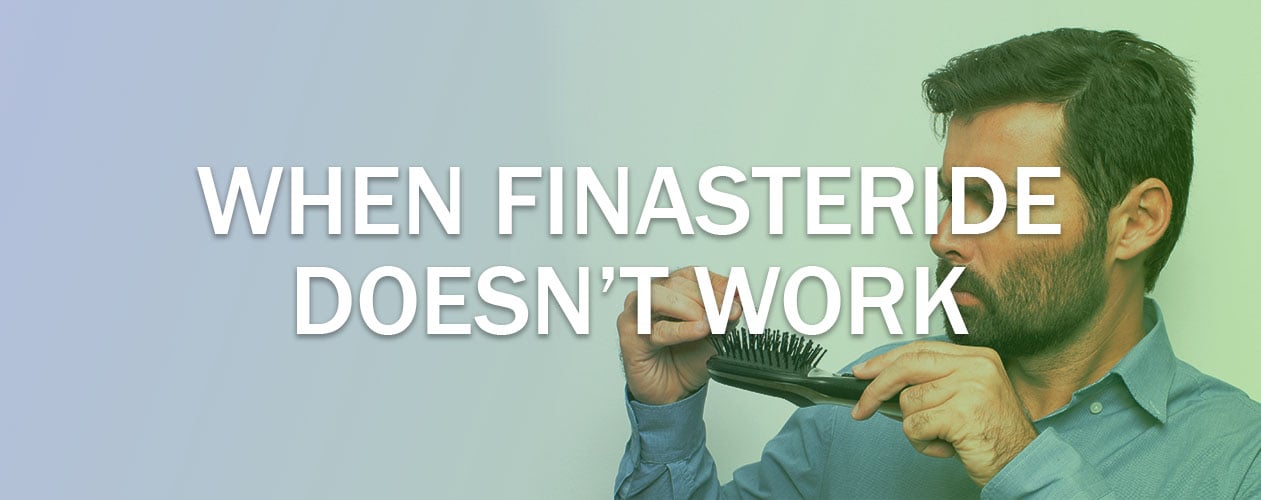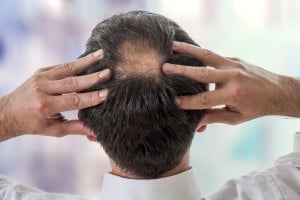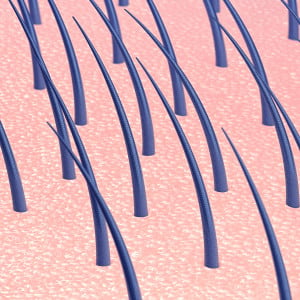When Finasteride Doesn’t Work

You might be wondering why there are so many people out there with significant hair loss and doing nothing for that, taking into consideration there are solutions available which can slow down or stop baldness completely. Well, the main reason is the lack of education about which hair loss treatments actually work. There’s a lot of misinformation when it comes to hair loss remedies; having a lot of claims about many marketed products that they do work while they are not, and the false guarantees made by armchair experts to stop baldness are also counted. This makes finding reliable information a challenge, thus here we tried to cover all about one of the most well-known medications used for that indication -‘’Finasteride’’- so make sure you go through it all to have a step taken in the right direction.
Finasteride is one of the most popular hair loss treatment methods that come in the form of a once-a-day pill. When taking finasteride, one should expect:

Finasteride aids in stopping baldness
After testing different treatment methods for pattern baldness, finasteride was found to be incredibly effective at stopping hair loss. Investigating finasteride for pattern hair loss led to two major observation: nearly 85% of the men who took it in clinical trials stopped losing hair as a result of taking the drug. 50% of the participants even experienced not just the stoppage of loss, but also the actual regrowth in their first year of using the drug. More than 66% experienced great results after having taken the drug regularly going on to two years. Thus, it has been successfully used as a treatment program for individuals who are unhappy with their hair loss.
Finasteride halts hair loss from the roots
Finasteride’s mechanism of action is based on preventing the conversion of testosterone into dihydrotestosterone which is a male androgen that’s been linked to balding. Thus, for a lot of men, finasteride is able to effectively prevent male pattern baldness by decreasing the amount of dihydrotestosterone present in the scalp. Studies have linked the relationship between finasteride and reduced levels of scalp dihydrotestosterone and demonstrated that a daily dose of 1 mg finasteride is enough to reduce the amount of dihydrotestosterone in the scalp by more than 60%.
Finasteride is one of the most effective ways to combat hair loss
When it comes to hair loss treatments, finasteride is one of the most effective treatments against male pattern baldness. In reported literature, it was found that finasteride’s effectiveness was better when compared to another popular treatment (5% minoxidil). It was stated that 80% of the patients who used finasteride have had thick hair regrowth, while only 52% of the ones on minoxidil enjoyed similar results. Results of various studies also favoured finasteride over other medications.
For best results, finasteride requires commitment
A very important thing to put in mind is that successful hair loss treatment doesn’t come in the form of a quick fix. It’s something that takes time to work – usually a couple of months – and requires consistency and commitment. While finasteride is designed to inhibit dihydrotestosterone and stimulate hair growth, you need to continue taking it to fully benefit from its effects. If you stop taking finasteride abruptly, you’re not going to like the result. More often than not, the hair you grew back will fall out and the balding process as a whole will resume where it left off. Reports demonstrate that people who discontinued their finasteride treatment lost all of the hair they regrew over a period of six to nine months.
So, why doesn’t it work for some people?
The most likely reason for finasteride not to work is quite simple and -you’d love hearing that- easy to correct, that is consistency. If you stop and start or miss days or doses, as with most medications, your treatment will be less effective. It may even stop working altogether.
The reason being dedicated in your use is so crucial is because you are trying to maintain the level of the drug in your bloodstream – something called the ‘therapeutic level’ – as this is what makes any medication effective. Taking the daily dose of finasteride would maintain its therapeutic level of finasteride, but it worth mentioning that it usually takes six to nine months to see the full effects, since hair follicles require plenty of time to produce new hairs.
What finasteride does is that it induces the anagen phase (hair growing phase). It promotes the re-entry of the resting hair follicles into this anagen phase including those that have been abnormally prolonged their telogen phase (resting phase in which the hair begins to grow again to produce new hair). Before the hair starts growing again (telogen phase) it usually sheds. That is absolutely normal, but some people think that the drug is not working, and they stop taking their doses. Depending on the extent of thinning and the level of regrowth from treatment which varies from person to person, the results can take from three to six months and sometimes up to one year to become noticeable.
Another category who can’t benefit from the finasteride includes who may experience the reported side effects. They are mainly sexual such as decreased libido and difficulty to maintain an erection. The good news here is, this group is only estimated by 1-2% of people using finasteride.

What to consider if you were unlucky?
Next, are some other natural options and treatments considered as alternatives to finasteride:
Ayurvedic treatment
Ayurveda believes that hair fall control is very much associated with the body type and also the stability of your mind-body structure. Ayurveda considers the hair as a by-product for bone formation. The tissues which are responsible for the formation of bones are also responsible for your hair growth. Some claims that ayurvedic hair loss treatment measures are known for their effectiveness. Usually, the Ayurvedic treatment for hair loss includes diet, meditation, yoga, and medicated herbal oil massage.
Zinc
Zinc is an essential mineral whose extreme deficiency can cause hair loss according to the National Institute of Health. However, many studies have looked at the effects of zinc on hair loss, though most have focused solely on alopecia areata, an autoimmune disease. Most men coping with hair loss have androgenetic alopecia. While these two forms of hair loss may have different causes, they also have things in common, making the research on alopecia areata potentially useful for men with pattern baldness, too. So, if your hair loss was due to the zinc deficiency, consult the healthcare professional and put an end to your suffering. Make sure that you have lower than normal levels of zinc first as the risks associated with taking zinc supplementation are many, but typically reserved for those taking very high amounts of the mineral.
Hair Transplant Surgery
The first alternative to finasteride is not always the most popular. Hair transplant surgery is an effective solution, however, many are surprised to know how expensive it can be. With the average procedure requiring the transplant of 1,500 or more grafts— with 2nd and 3rd procedures often required— it’s easy to see why so many men baulk at the idea of seeking a surgical solution.
Topical Hair Loss Foam
Another alternative is the use of a topical hair loss foam, like Minoxidil. Yet, as stated earlier, this is less effective than finasteride and was reported to induce new hair growth in very few patients. It is a vasodilator and it works by increasing blood flow to the area where it is applied and in result stimulating hair follicles. This topical foam must be applied twice daily in order to be effective and only works when it is actively used.
Low-Level Laser Therapy (LLLT)
Low-level laser therapy (LLLT) is a non-surgical hair loss treatment option for those who suffer from various forms of hair loss, including androgenetic alopecia. LLLT leverages the power of medical-grade laser light to stimulate blood flow across the scalp. This has at least two major benefits that help to stop hair loss. First, stimulation from LLLT improves blood flow to the scalp, carrying more oxygen, nutrients, and growth factors directly to each hair follicle. Second, LLLT is believed to induce phototherapy, a biological process through which cellular activity increases. Together, these powerful effects help to revive hair follicles and produce thicker, fuller hair.
The final say would be that finasteride is one of the few hair loss treatments to be clinically tested and verified to give noticeable results for the majority of individuals.
References
- Drake L, Hordinsky M, Fiedler V, Swinehart J, Unger WP, Cotterill PC, Thiboutot DM, Lowe N, Jacobson C, Whiting D. The effects of finasteride on scalp skin and serum androgen levels in men with androgenetic alopecia. Journal of the American Academy of Dermatology 1999;41:550-54.
- Van Neste D, Fuh V, Sanchez‐Pedreno P, Lopez‐Bran E, Wolff H, Whiting D, Roberts J, Kopera D, Stene JJ, Calvieri S. Finasteride increases anagen hair in men with androgenetic alopecia. British Journal of Dermatology 2000;143:804-10.
- Finn DA, Beadles‐Bohling AS, Beckley EH, Ford MM, Gililland KR, Gorin‐Meyer RE, Wiren KM. A new look at the 5α‐reductase inhibitor finasteride. CNS drug reviews 2006;12:53-76.
- Finasteride Male Pattern Hair Loss Study G. Long-term (5-year) multinational experience with finasteride 1 mg in the treatment of men with androgenetic alopecia. European Journal of Dermatology 2002;12:38-49.
- Mysore V. Finasteride and sexual side effects. Indian Dermatology online journal 2012;3:62.
- Mella JM, Perret MC, Manzotti M, Catalano HN, Guyatt G. Efficacy and safety of finasteride therapy for androgenetic alopecia: a systematic review. Archives of dermatology 2010;146:1141-50.
- https://ayurveda-foryou.com
- https://www.nih.gov/
- Obi OK. What is the Efficacy of Finasteride Therapy in Reducing or Reversing Hair Loss? 2012.
- Mella JM, Perret MC, Manzotti M, Catalano HN, Guyatt G. Efficacy and safety of finasteride therapy for androgenetic alopecia: a systematic review. Archives of dermatology 2010;146:1141-50.


